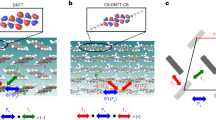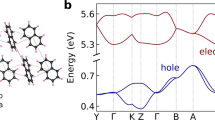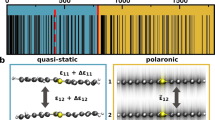Abstract
The energy band structure provides crucial information on charge transport behaviour in organic semiconductors, such as effective mass, transfer integrals and electron–phonon coupling. Despite the discovery of the valence (the highest occupied molecular orbital (HOMO)) band structure in the 1990s, the conduction band (the lowest unoccupied molecular orbital (LUMO)) has not been experimentally observed. Here we employ angle-resolved low-energy inverse photoelectron spectroscopy to reveal the LUMO band structure of pentacene, a prototypical high-mobility organic semiconductor. The derived transfer integrals and bandwidths from the LUMO are substantially smaller than those predicted by density functional theory calculations. To reproduce this bandwidth reduction, we propose an improved (partially dressed) polaron model that accounts for the electron–intramolecular vibrational interaction with frequency-dependent coupling constants based on Debye relaxation. This model quantitatively reproduces not only the transfer integrals, but also the temperature-dependent HOMO and LUMO bandwidths, and the hole and electron mobilities. The present results demonstrate that electron mobility in high-mobility organic semiconductors is indeed limited by polaron formation.
This is a preview of subscription content, access via your institution
Access options
Access Nature and 54 other Nature Portfolio journals
Get Nature+, our best-value online-access subscription
$29.99 / 30 days
cancel any time
Subscribe to this journal
Receive 12 print issues and online access
$259.00 per year
only $21.58 per issue
Buy this article
- Purchase on Springer Link
- Instant access to full article PDF
Prices may be subject to local taxes which are calculated during checkout





Similar content being viewed by others
Data availability
All the data supporting the findings of this study are available within the article, its Supplementary Information files or from the corresponding authors upon request.
Code availability
The electronic-state-calculation codes used in this paper are Quantum ESPRESSO, Wannier90 and GAMESS. Detailed information related to the license and user guide for these codes are available at https://www.quantum-espresso.org/, http://www.wannier.org/ and https://www.msg.chem.iastate.edu/gamess/.
References
Karl, N. Charge carrier transport in organic semiconductors. Synth. Met. 133–134, 649–657 (2003).
Podzorov, V., Menard, E., Rogers, J. A. & Gershenson, M. E. Hall effect in the accumulation layers on the surface of organic semiconductors. Phys. Rev. Lett. 95, 226601 (2005).
Hasegawa, T. & Takeya, J. Organic field-effect transistors using single crystals. Sci. Technol. Adv. Mater. 10, 024314 (2009).
Lin, Y. J., Tsao, H. Y. & Liu, D. S. Hall-effect mobility of pentacene films prepared by the thermal evaporating method with different substrate temperature. Appl. Phys. Lett. 101, 013302 (2012).
Marumoto, K., Kuroda, S. I., Takenobu, T. & Iwasa, Y. Spatial extent of wave functions of gate-induced hole carriers in pentacene field-effect devices as investigated by electron spin resonance. Phys. Rev. Lett. 97, 256603 (2006).
Ueno, N. & Kera, S. Electron spectroscopy of functional organic thin films: deep insights into valence electronic structure in relation to charge transport property. Prog. Surf. Sci. 83, 490–557 (2008).
Martinelli, N. G. et al. Influence of intermolecular vibrations on the electronic coupling in organic semiconductors: the case of anthracene and perfluoropentacene. ChemPhysChem 10, 2265–2273 (2009).
Gershenson, M. E., Podzorov, V. & Morpurgo, A. F. Colloquium: Electronic transport in single-crystal organic transistors. Rev. Mod. Phys. 78, 973–989 (2006).
Nematiaram, T. & Troisi, A. Modeling charge transport in high-mobility molecular semiconductors: balancing electronic structure and quantum dynamics methods with the help of experiments. J. Chem. Phys. 152, 190902 (2020).
Schweicher, G. et al. Molecular semiconductors for logic operations: dead-end or bright future? Adv. Mater. 32, 1905909 (2020).
Schweicher, G., Olivier, Y., Lemaur, V. & Geerts, Y. H. What currently limits charge carrier mobility in crystals of molecular semiconductors? Isr. J. Chem. 54, 595–620 (2014).
Fratini, S., Mayou, D. & Ciuchi, S. The transient localization scenario for charge transport in crystalline organic materials. Adv. Funct. Mater. 26, 2292–2315 (2016).
Liu, C. et al. A unified understanding of charge transport in organic semiconductors: the importance of attenuated delocalization for the carriers. Mater. Horiz. 4, 608–618 (2017).
Oberhofer, H., Reuter, K. & Blumberger, J. Charge transport in molecular materials: an assessment of computational methods. Chem. Rev. 117, 10319–10357 (2017).
Troisi, A. & Orlandi, G. Charge-transport regime of crystalline organic semiconductors: diffusion limited by thermal off-diagonal electronic disorder. Phys. Rev. Lett. 96, 086601 (2006).
Holstein, T. Studies of polaron motion. Part II. The ‘small’ polaron. Ann. Phys. (N Y) 8, 343–389 (1959).
Hannewald, K. et al. Theory of polaron bandwidth narrowing in organic molecular crystals. Phys. Rev. B 69, 075211 (2004).
Ciuchi, S. & Fratini, S. Band dispersion and electronic lifetimes in crystalline organic semiconductors. Phys. Rev. Lett. 106, 166403 (2011).
Koch, N. et al. Evidence for temperature-dependent electron band dispersion in pentacene. Phys. Rev. Lett. 96, 156803 (2006).
Hatch, R. C., Huber, D. L. & Höchst, H. Electron–phonon coupling in crystalline pentacene films. Phys. Rev. Lett. 104, 047601 (2010).
Nakayama, Y. et al. Single-crystal pentacene valence-band dispersion and its temperature dependence. J. Phys. Chem. Lett. 8, 1259–1264 (2017).
Li, Y., Coropceanu, V. & Brédas, J. L. Thermal narrowing of the electronic bandwidths in organic molecular semiconductors: impact of the crystal thermal expansion. J. Phys. Chem. Lett. 3, 3325–3329 (2012).
Coropceanu, V. et al. Charge transport in organic semiconductors. Chem. Rev. 107, 926–952 (2007).
Frank, K. H., Yannoulis, P., Dudde, R. & Koch, E. E. Unoccupied molecular orbitals of aromatic hydrocarbons adsorbed on Ag(111). J. Chem. Phys. 89, 7569–7576 (1988).
Hill, I. G. et al. Occupied and unoccupied electronic levels in organic π-conjugated molecules: Comparison between experiment and theory. Chem. Phys. Lett. 317, 444–450 (2000).
Yoshida, H., Tsutsumi, K. & Sato, N. Unoccupied electronic states of 3d-transition metal phthalocyanines (MPc: M = Mn, Fe, Co, Ni, Cu and Zn) studied by inverse photoemission spectroscopy. J. Electron Spectros. Relat. Phenomena 121, 83–91 (2001).
Zahn, D. R. T., Gavrila, G. N. & Gorgoi, M. The transport gap of organic semiconductors studied using the combination of direct and inverse photoemission. Chem. Phys. 325, 99–112 (2006).
Krause, S., Casu, M. B., Schöll, A. & Umbach, E. Determination of transport levels of organic semiconductors by UPS and IPS. New J. Phys. 10, 085001 (2008).
Kanai, K. et al. Determination of electron affinity of electron accepting molecules. Appl. Phys. A 95, 309–313 (2009).
Dose, V. Momentum-resolved inverse photoemission. Surf. Sci. Rep. 5, 337–378 (1985).
Yoshida, H. Near-ultraviolet inverse photoemission spectroscopy using ultra-low energy electrons. Chem. Phys. Lett. 539–540, 180–185 (2012).
Yoshida, H. Principle and application of low energy inverse photoemission spectroscopy: a new method for measuring unoccupied states of organic semiconductors. J. Electron Spectros. Relat. Phenom. 204, 116–124 (2015).
Yoshida, H., Inaba, K. & Sato, N. X-ray diffraction reciprocal space mapping study of the thin film phase of pentacene. Appl. Phys. Lett. 90, 181930 (2007).
Yoshida, H. & Sato, N. Crystallographic and electronic structures of three different polymorphs of pentacene. Phys. Rev. B 77, 235205 (2008).
Zhou, S. Y. et al. Coexistence of sharp quasiparticle dispersions and disorder features in graphite. Phys. Rev. B 71, 161403 (2005).
Park, S. et al. Electronic band dispersion determination in azimuthally disordered transition-metal dichalcogenide monolayers. Commun. Phys. 2, 68 (2019).
Giannozzi, P. et al. QUANTUM ESPRESSO: a modular and open-source software project for quantum simulations of materials. J. Phys. Condens. Matter 21, 395502 (2009).
Berland, K. et al. van der Waals forces in density functional theory: a review of the vdW-DF method. Rep. Prog. Phys. 78, 066501 (2015).
Mostofi, A. A. et al. wannier90: a tool for obtaining maximally-localised Wannier functions. Comput. Phys. Commun. 178, 685–699 (2008).
Tiago, M. L. et al. Ab initio calculation of the electronic and optical properties of solid pentacene. Phys. Rev. B 67, 115212 (2003).
Yanagisawa, S. & Hamada, I. Determination of geometric and electronic structures of organic crystals from first principles: role of the molecular configuration on the electronic structure. J. Appl. Phys. 121, 45501 (2017).
Ortmann, F., Bechstedt, F. & Hannewald, K. Theory of charge transport in organic crystals: beyond Holstein’s small-polaron model. Phys. Rev. B 79, 235206 (2009).
Fratini, S. & Ciuchi, S. Dynamical localization corrections to band transport. Phys. Rev. Res. 2, 13001 (2020).
Houili, H., Picon, J. D., Zuppiroli, L. & Bussac, M. N. Polarization effects in the channel of an organic field-effect transistor. J. Appl. Phys. 100, 23702 (2006).
Von Helden, L., Breuer, T. & Witte, G. Anisotropic thermal expansion in pentacene and perfluoropentacene: effects of molecular packing motif and fixation at the interface. Appl. Phys. Lett. 110, 141904 (2017).
Lukas, S., Söhnchen, S., Witte, G. & Wöll, C. Epitaxial growth of pentacene films on metal surfaces. ChemPhysChem 5, 266–270 (2004).
Yasuda, T., Goto, T., Fujita, K. & Tsutsui, T. Ambipolar pentacene field-effect transistors with calcium source-drain electrodes. Appl. Phys. Lett. 85, 2098–2100 (2004).
Chua, L. L. et al. General observation of n-type field-effect behaviour in organic semiconductors. Nature 434, 194–199 (2005).
Chiu, L. Y. et al. Manipulating the ambipolar characteristics of pentacene-based field-effect transistors. J. Mater. Chem. C 2, 1823–1829 (2014).
Saudari, S. R. & Kagan, C. R. Electron and hole transport in ambipolar, thin film pentacene transistors. J. Appl. Phys. 117, 035501 (2015).
Ishii, H., Inoue, J. I., Kobayashi, N. & Hirose, K. Quantitative mobility evaluation of organic semiconductors using quantum dynamics based on density functional theory. Phys. Rev. B 98, 235422 (2018).
Ishii, H., Kobayashi, N. & Hirose, K. Order-N electron transport calculations from ballistic to diffusive regimes by a time-dependent wave-packet diffusion method: application to transport properties of carbon nanotubes. Phys. Rev. B 82, 085435 (2010).
Fratini, S. et al. A map of high-mobility molecular semiconductors. Nat. Mater. 16, 998–1002 (2017).
Yoshida, H. Note: Low energy inverse photoemission spectroscopy apparatus. Rev. Sci. Instrum. 85, 016101 (2014).
Schmidt, M. W. et al. General atomic and molecular electronic structure system. J. Comput. Chem. 14, 1347–1363 (1993).
Yamane, H. et al. Hole-vibration coupling of the highest occupied state in pentacene thin films. Phys. Rev. B 72, 153412 (2005).
Computational Chemistry Comparison and Benchmark DataBase. Precomputed Vibrational Scaling Factors (National Institute of Standards and Technology, 2015); https://cccbdb.nist.gov/vibscalejust.asp
Ishii, H., Kobayashi, N. & Hirose, K. Charge transport calculations by a wave-packet dynamical approach using maximally localized Wannier functions based on density functional theory: application to high-mobility organic semiconductors. Phys. Rev. B 95, 035433 (2017).
Goto, H., Obata, S., Nakayama, N. & Ohta, K. CONFLEX 8 (Conflex, 2017).
Acknowledgements
The authors thank N. Ueno for stimulating and helpful discussion on the electron–phonon coupling of organic semiconductors. This work was supported by JSPS KAKENHI (JP26288007, JP18H01856, JP21H01902 and JP21H05472), JST PRESTO, CREST (JPMJCR21Q1), and the Futaba Research Grant Program of the Futaba Foundation. H.S. thanks the JST SPRING grant (JPMJSP2109) for financial support. H.I. acknowledges financial support from the University of Tsukuba, Pre-Strategic Initiatives ‘Development Center for High-Function and High-Performance Organic–Inorganic Spin Electronics’.
Author information
Authors and Affiliations
Contributions
H.Y. created the concept of this work. H.S., S.A.A.R. and Y.Y. acquired and analysed the experimental data. H.I. and H.Y. performed the theoretical analysis. H.S. and H.Y. wrote the manuscript.
Corresponding authors
Ethics declarations
Competing interests
The authors declare no competing interests.
Peer review
Peer review information
Nature Materials thanks Antoine Kahn, Peter Puschnig and the other, anonymous, reviewer(s) for their contribution to the peer review of this work.
Additional information
Publisher’s note Springer Nature remains neutral with regard to jurisdictional claims in published maps and institutional affiliations.
Supplementary information
Supplementary Information
Supplementary Figs. S1–S9, Tables S1–S9 and sections S1–S12.
Supplementary Data CIF1
Crystallographic data (CIF file) of pentacene thin-film phase at 300 K of temperature based on the lattice constants given in Yoshida et al [Ref. 33].
Supplementary Data CIF2
Crystallographic data (CIF file) of pentacene thin-film phase at 300 K of temperature based on the lattice constants given in Nabok et al [Ref. S6].
Supplementary Data CIF3
Crystallographic data (CIF file) of pentacene thin-film phase at 120 K of temperature based on the lattice constants given in Yoshida et al [Ref. 33].
Supplementary Data CIF4
Crystallographic data (CIF file) of pentacene thin-film phase at 220 K of temperature based on the lattice constants given in Yoshida et al [Ref. 33].
Rights and permissions
About this article
Cite this article
Sato, H., Abd. Rahman, S.A., Yamada, Y. et al. Conduction band structure of high-mobility organic semiconductors and partially dressed polaron formation. Nat. Mater. 21, 910–916 (2022). https://doi.org/10.1038/s41563-022-01308-z
Received:
Accepted:
Published:
Issue Date:
DOI: https://doi.org/10.1038/s41563-022-01308-z
This article is cited by
-
Theoretical design and evaluation of efficient small donor molecules for organic solar cells
Journal of Molecular Modeling (2023)
-
Exploration of B-site alloying in partially reducing Pb toxicity and regulating thermodynamic stability and electronic properties of halide perovskites
Science China Physics, Mechanics & Astronomy (2023)



